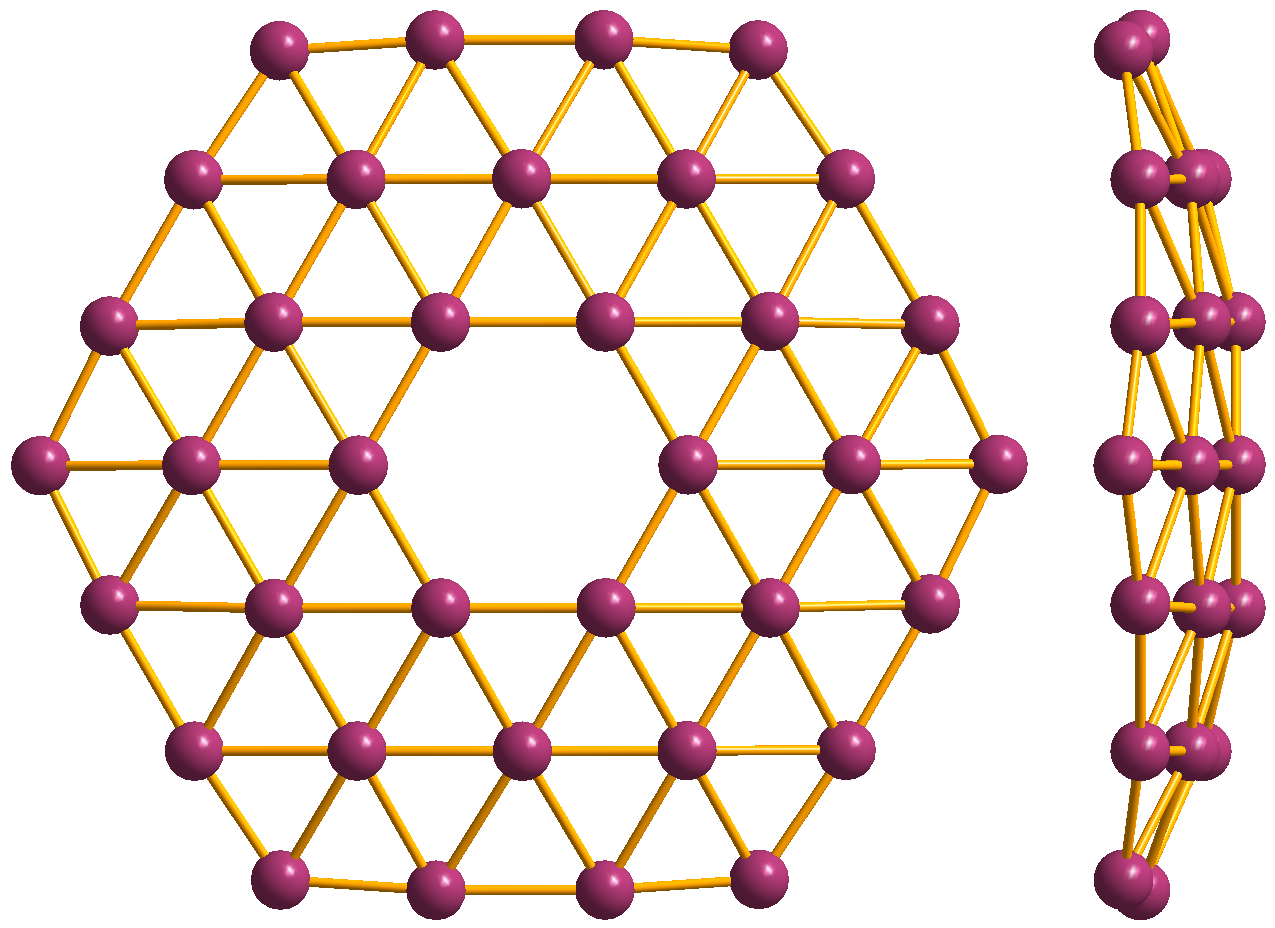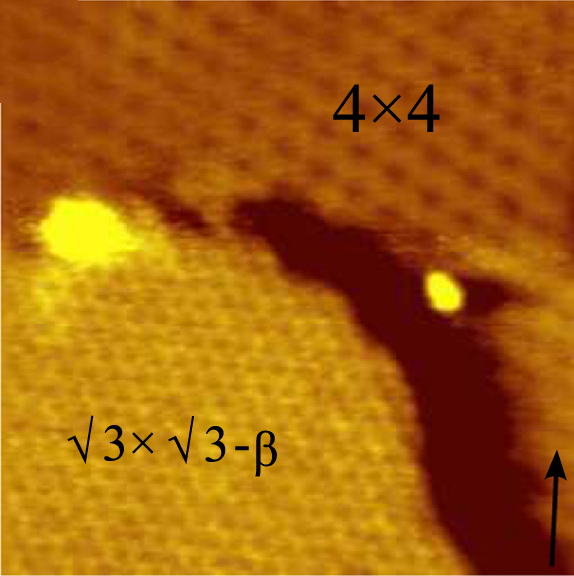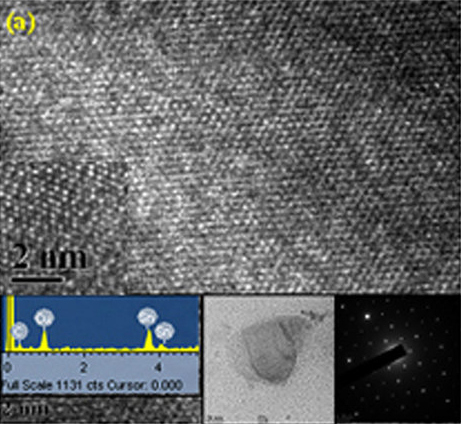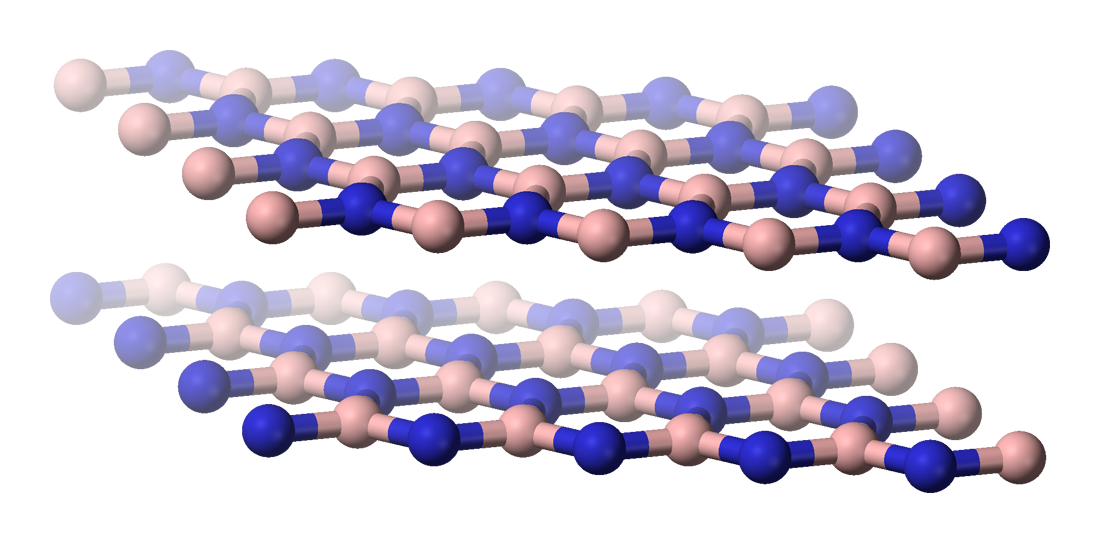Single-layer Materials on:
[Wikipedia]
[Google]
[Amazon]
In materials science, the term single-layer materials or 2D materials refers to



 Stanene is a predicted
Stanene is a predicted

 Single and double atom layers of
Single and double atom layers of
 * Titanate nanosheet
* Borocarbonitrides
*
* Titanate nanosheet
* Borocarbonitrides
*
crystal
A crystal or crystalline solid is a solid material whose constituents (such as atoms, molecules, or ions) are arranged in a highly ordered microscopic structure, forming a crystal lattice that extends in all directions. In addition, macros ...
line solids consisting of a single layer of atoms. These materials are promising for some applications but remain the focus of research. Single-layer materials derived from single elements generally carry the -ene suffix in their names, e.g. graphene
Graphene () is an allotrope of carbon consisting of a single layer of atoms arranged in a hexagonal lattice nanostructure.
. Single-layer materials that are compounds of two or more elements have -ane or -ide suffixes. 2D materials can generally be categorized as either 2D allotropes of various elements or as compounds (consisting of two or more covalently bonding elements).
It is predicted that there are hundreds of stable single-layer materials. The atomic structure and calculated basic properties of these and many other potentially synthesisable single-layer materials, can be found in computational databases. 2D materials can be produced using mainly two approaches: top-down exfoliation and bottom-up synthesis. The exfoliation methods include sonication, mechanical, hydrothermal, electrochemical, laser-assisted, and microwave-assisted exfoliation.
Single element materials
C: graphene and graphyne
;Graphene
Graphene
Graphene () is an allotrope of carbon consisting of a single layer of atoms arranged in a hexagonal lattice nanostructure.
is a crystal
A crystal or crystalline solid is a solid material whose constituents (such as atoms, molecules, or ions) are arranged in a highly ordered microscopic structure, forming a crystal lattice that extends in all directions. In addition, macros ...
line allotrope
Allotropy or allotropism () is the property of some chemical elements to exist in two or more different forms, in the same physical state, known as allotropes of the elements. Allotropes are different structural modifications of an element: the ...
of carbon
Carbon () is a chemical element with the symbol C and atomic number 6. It is nonmetallic and tetravalent
In chemistry, the valence (US spelling) or valency (British spelling) of an element is the measure of its combining capacity with o ...
in the form of a nearly transparent (to visible light) one atom thick sheet. It is hundreds of times stronger than most steel
Steel is an alloy made up of iron with added carbon to improve its strength and fracture resistance compared to other forms of iron. Many other elements may be present or added. Stainless steels that are corrosion- and oxidation-resistant ty ...
s by weight. It has the highest known thermal and electrical conductivity, displaying current densities 1,000,000 times that of copper
Copper is a chemical element with the symbol Cu (from la, cuprum) and atomic number 29. It is a soft, malleable, and ductile metal with very high thermal and electrical conductivity. A freshly exposed surface of pure copper has a pinkis ...
. It was first produced in 2004.
Andre Geim
, birth_date =
, birth_place = Sochi, Russian SFSR, Soviet Union
, death_date =
, death_place =
, workplaces =
, nationality = Dutch and British
, fields = Condensed matter physics
...
and Konstantin Novoselov
Sir Konstantin Sergeevich Novoselov ( rus, Константи́н Серге́евич Новосёлов,
p=kənstɐnʲˈtʲin sʲɪrˈɡʲe(j)ɪvʲɪtɕ nəvɐˈsʲɵləf; born 1974) is a Russian-British physicist, and a professor at the ...
won the 2010 Nobel Prize in Physics
)
, image = Nobel Prize.png
, alt = A golden medallion with an embossed image of a bearded man facing left in profile. To the left of the man is the text "ALFR•" then "NOBEL", and on the right, the text (smaller) "NAT•" then " ...
"for groundbreaking experiments regarding the two-dimensional material graphene". They first produced it by lifting graphene flakes from bulk graphite with adhesive tape and then transferring them onto a silicon wafer.
;Graphyne
Graphyne
Graphyne is an allotrope of carbon. Its structure is one-atom-thick planar sheets of sp and sp2-bonded carbon atoms arranged in crystal lattice. It can be seen as a lattice of benzene rings connected by acetylene bonds. The material is call ...
is another 2-dimensional carbon allotrope whose structure is similar to graphene's. It can be seen as a lattice of benzene
Benzene is an organic chemical compound with the molecular formula C6H6. The benzene molecule is composed of six carbon atoms joined in a planar ring with one hydrogen atom attached to each. Because it contains only carbon and hydrogen atoms, ...
rings connected by acetylene
Acetylene (systematic name: ethyne) is the chemical compound with the formula and structure . It is a hydrocarbon and the simplest alkyne. This colorless gas is widely used as a fuel and a chemical building block. It is unstable in its pure ...
bonds. Depending on the content of the acetylene groups, graphyne can be considered a mixed hybridization
Hybridization (or hybridisation) may refer to:
*Hybridization (biology), the process of combining different varieties of organisms to create a hybrid
*Orbital hybridization, in chemistry, the mixing of atomic orbitals into new hybrid orbitals
*Nu ...
, spn, where 1 < n < 2, compared to graphene (pure sp2) and diamond
Diamond is a Allotropes of carbon, solid form of the element carbon with its atoms arranged in a crystal structure called diamond cubic. Another solid form of carbon known as graphite is the Chemical stability, chemically stable form of car ...
(pure sp3).
First-principle calculations using phonon dispersion curves and ab-initio
''Ab initio'' ( ) is a Latin term meaning "from the beginning" and is derived from the Latin ''ab'' ("from") + ''initio'', ablative singular of ''initium'' ("beginning").
Etymology
Circa 1600, from Latin, literally "from the beginning", from ab ...
finite temperature, quantum mechanical molecular dynamics simulations showed graphyne and its boron nitride
Boron nitride is a thermally and chemically resistant refractory compound of boron and nitrogen with the chemical formula BN. It exists in various crystalline forms that are isoelectronic to a similarly structured carbon lattice. The hexagonal ...
analogues to be stable.
The existence of graphyne was conjectured before 1960. It has not yet been synthesized. However, graphdiyne (graphyne with diacetylene
Diacetylene (also known as butadiyne) is the organic compound with the formula C4H2. It is the simplest compound containing two triple bonds. It is first in the series of polyynes, which are of theoretical but not of practical interest.
Occurr ...
groups) was synthesized on copper substrates. Recently, it has been claimed to be a competitor for graphene due to the potential of direction-dependent Dirac cones.
B: borophene

Borophene
Borophene is a crystalline atomic monolayer of boron, i.e., it is a two-dimensional allotrope of boron and also known as ''boron sheet''.
First predicted by theory in the mid-1990s,
different borophene structures were experimentally confirmed i ...
is a crystalline atomic monolayer A monolayer is a single, closely packed layer of atoms, molecules, or cells. In some cases it is referred to as a self-assembled monolayer. Monolayers of layered crystals like graphene and molybdenum disulfide are generally called 2D materials.
...
of boron
Boron is a chemical element with the symbol B and atomic number 5. In its crystalline form it is a brittle, dark, lustrous metalloid; in its amorphous form it is a brown powder. As the lightest element of the ''boron group'' it has th ...
and is also known as ''boron sheet''.
First predicted by theory in the mid-1990s in a freestanding state, and then demonstrated as distinct monoatomic layers on substrates by Zhang et al.,
different borophene structures were experimentally confirmed in 2015.
Ge: germanene
Germanene
Germanene is a material made up of a single layer of germanium atoms. The material is created in a process similar to that of silicene and graphene, in which high vacuum and high temperature are used to deposit a layer of germanium atoms on a sub ...
is a two-dimensional allotrope of germanium
Germanium is a chemical element with the symbol Ge and atomic number 32. It is lustrous, hard-brittle, grayish-white and similar in appearance to silicon. It is a metalloid in the carbon group that is chemically similar to its group neighbors s ...
with a buckled honeycomb structure.
Experimentally synthesized germanene exhibits a honeycomb structure.
This honeycomb
A honeycomb is a mass of Triangular prismatic honeycomb#Hexagonal prismatic honeycomb, hexagonal prismatic Beeswax, wax cells built by honey bees in their beehive, nests to contain their larvae and stores of honey and pollen.
beekeeping, Beekee ...
structure consists of two hexagon
In geometry, a hexagon (from Ancient Greek, Greek , , meaning "six", and , , meaning "corner, angle") is a six-sided polygon. The total of the internal angles of any simple polygon, simple (non-self-intersecting) hexagon is 720°.
Regular hexa ...
al sub-lattices that are vertically displaced by 0.2 A from each other.
Si: silicene

Silicene
Silicene is a two-dimensional allotrope of silicon, with a hexagonal honeycomb structure similar to that of graphene. Contrary to graphene, silicene is not flat, but has a periodically buckled topology; the coupling between layers in silicene is ...
is a two-dimensional allotrope of silicon
Silicon is a chemical element with the symbol Si and atomic number 14. It is a hard, brittle crystalline solid with a blue-grey metallic luster, and is a tetravalent metalloid and semiconductor. It is a member of group 14 in the periodic tab ...
, with a hexagonal honeycomb structure similar to that of graphene. Its growth is scaffolded by a pervasive Si/Ag(111) surface alloy beneath the two-dimensional layer.
Sn: stanene
 Stanene is a predicted
Stanene is a predicted topological insulator
A topological insulator is a material whose interior behaves as an electrical insulator while its surface behaves as an electrical conductor, meaning that electrons can only move along the surface of the material.
A topological insulator is an ...
that may display dissipationless currents at its edges near room temperature
Colloquially, "room temperature" is a range of air temperatures that most people prefer for indoor settings. It feels comfortable to a person when they are wearing typical indoor clothing. Human comfort can extend beyond this range depending on ...
. It is composed of tin
Tin is a chemical element with the symbol Sn (from la, stannum) and atomic number 50. Tin is a silvery-coloured metal.
Tin is soft enough to be cut with little force and a bar of tin can be bent by hand with little effort. When bent, t ...
atoms arranged in a single layer, in a manner similar to graphene. Its buckled structure leads to high reactivity against common air pollutants such as NOx and COx and it is able to trap and dissociate them at low temperature.
A structure determination of stanene using low energy electron diffraction has shown ultra-flat stanene on a Cu(111) surface.
Pb: plumbene
Plumbene is a two-dimensional allotrope oflead
Lead is a chemical element with the symbol Pb (from the Latin ) and atomic number 82. It is a heavy metal that is denser than most common materials. Lead is soft and malleable, and also has a relatively low melting point. When freshly cu ...
, with a hexagonal honeycomb structure similar to that of graphene.
P: phosphorene

Phosphorene
Phosphorene is a 2D materials, two-dimensional material consisting of phosphorus. It consists of a single layer of the artificially made layered black phosphorus, the most stable Allotropes of phosphorus, allotrope of phosphorus. The designation ...
is a 2-dimensional, crystalline allotrope of phosphorus
Phosphorus is a chemical element with the symbol P and atomic number 15. Elemental phosphorus exists in two major forms, white phosphorus and red phosphorus, but because it is highly reactive, phosphorus is never found as a free element on Ear ...
. Its mono-atomic hexagonal structure makes it conceptually similar to graphene. However, phosphorene has substantially different electronic properties; in particular it possesses a nonzero band gap while displaying high electron mobility. This property potentially makes it a better semiconductor than graphene.
The synthesis of phosphorene mainly consists of micromechanical cleavage or liquid phase exfoliation methods. The former has a low yield while the latter produce free standing nanosheets in solvent and not on the solid support. The bottom-up approaches like chemical vapor deposition (CVD) are still blank because of its high reactivity. Therefore, in the current scenario, the most effective method for large area fabrication of thin films of phosphorene consists of wet assembly techniques like Langmuir-Blodgett involving the assembly followed by deposition of nanosheets on solid supports.
Sb: antimonene
Antimonene is a two-dimensional allotrope ofantimony
Antimony is a chemical element with the symbol Sb (from la, stibium) and atomic number 51. A lustrous gray metalloid, it is found in nature mainly as the sulfide mineral stibnite (Sb2S3). Antimony compounds have been known since ancient time ...
, with its atoms arranged in a buckled honeycomb lattice. Theoretical calculations predicted that antimonene would be a stable semiconductor in ambient conditions with suitable performance for (opto)electronics. Antimonene was first isolated in 2016 by micromechanical exfoliation and it was found to be very stable under ambient conditions. Its properties make it also a good candidate for biomedical and energy applications.
In a study made in 2018, antimonene modified screen-printed electrodes (SPE's) were subjected to a galvanostatic charge/discharge test using a two-electrode approach to characterize their supercapacitive properties. The best configuration observed, which contained 36 nanograms of antimonene in the SPE, showed a specific capacitance of 1578 F g−1 at a current of 14 A g−1. Over 10,000 of these galvanostatic cycles, the capacitance retention values drop to 65% initially after the first 800 cycles, but then remain between 65% and 63% for the remaining 9,200 cycles. The 36 ng antimonene/SPE system also showed an energy density of 20 mW h kg−1 and a power density of 4.8 kW kg−1. These supercapacitive properties indicate that antimonene is a promising electrode material for supercapacitor systems. A more recent study, concerning antimonene modified SPEs shows the inherent ability of antimonene layers to form electrochemically passivated layers to facilite electroanalytical measurements in oxygenated environments, in which the presence of dissolved oxygens normally hinders the analytical procedure. The same study also depicts the in-situ production of antimonene oxide/PEDOT:PSS nanocomposites as electrocatalytic platforms for the determination of nitroaromatic compounds.
Bi: bismuthene
Bismuthene, the two-dimensional (2D) allotrope ofbismuth
Bismuth is a chemical element with the Symbol (chemistry), symbol Bi and atomic number 83. It is a post-transition metal and one of the pnictogens, with chemical properties resembling its lighter group 15 siblings arsenic and antimony. Elemental ...
, was predicted to be a topological insulator. It was predicted that bismuthene retains its topological phase when grown on silicon carbide
Silicon carbide (SiC), also known as carborundum (), is a hard chemical compound containing silicon and carbon. A semiconductor, it occurs in nature as the extremely rare mineral moissanite, but has been mass-produced as a powder and crystal sin ...
in 2015. The prediction was successfully realized and synthesized in 2016. At first glance the system is similar to graphene, as the Bi atoms arrange in a honeycomb lattice. However the bandgap
In solid-state physics, a band gap, also called an energy gap, is an energy range in a solid where no electronic states can exist. In graphs of the electronic band structure of solids, the band gap generally refers to the energy difference (in ...
is as large as 800mV due to the large spin–orbit interaction
In quantum physics, the spin–orbit interaction (also called spin–orbit effect or spin–orbit coupling) is a relativistic interaction of a particle's spin with its motion inside a potential. A key example of this phenomenon is the spin–orbi ...
(coupling) of the Bi atoms and their interaction with the substrate. Thus, room-temperature applications of the quantum spin Hall effect The quantum spin Hall state is a state of matter proposed to exist in special, two-dimensional semiconductors that have a quantized spin-Hall conductance and a vanishing charge-Hall conductance. The quantum spin Hall state of matter is the cousin of ...
come into reach. It has been reported to be the largest nontrivial bandgap 2D topological insulator in its natural state. Top-down exfoliation of bismuthene has been reported in various instances with recent works promoting the implementation of bismuthene in the field of electrochemical sensing. Emdadul et al. predicted the mechanical strength and phonon thermal conductivity of monolayer β-bismuthene through atomic-scale analysis. The obtained room temperature (300K) fracture strength is ~4.21 N/m along the armchair direction and ~4.22 N/m along the zigzag direction. At 300 K, its Young's moduli are reported to be ~26.1 N/m and ~25.5 N/m, respectively, along the armchair and zigzag directions. In addition, their predicted phonon thermal conductivity of ~1.3 W/m∙K at 300 K is considerably lower than other analogous 2D honeycombs, making it a promising material for thermoelectric operations.
Metals
platinum
Platinum is a chemical element with the symbol Pt and atomic number 78. It is a dense, malleable, ductile, highly unreactive, precious, silverish-white transition metal. Its name originates from Spanish , a diminutive of "silver".
Platinu ...
in a two-dimensional film geometry has been demonstrated. These atomically thin platinum films are epitaxially
Epitaxy refers to a type of crystal growth or material deposition in which new crystalline layers are formed with one or more well-defined orientations with respect to the crystalline seed layer. The deposited crystalline film is called an epit ...
grown on graphene which imposes a compressive strain that modifies the surface chemistry of the platinum, while also allowing charge transfer through the graphene. Single atom layers of palladium
Palladium is a chemical element with the symbol Pd and atomic number 46. It is a rare and lustrous silvery-white metal discovered in 1803 by the English chemist William Hyde Wollaston. He named it after the asteroid Pallas, which was itself na ...
with the thickness down to 2.6 Å, and rhodium
Rhodium is a chemical element with the symbol Rh and atomic number 45. It is a very rare, silvery-white, hard, corrosion-resistant transition metal. It is a noble metal and a member of the platinum group. It has only one naturally occurring isoto ...
with the thickness of less than 4 Å have also been synthesized and characterized with atomic force microscopy and transmission electron microscopy.
2D alloys
Two-dimensional alloys (or surface alloys) are a single atomic layer of alloy that is incommensurate with the underlying substrate. One example is the 2D ordered alloys of Pb with Sn and with Bi. Surface alloys have been found to scaffold two-dimensional layers, as in the case ofsilicene
Silicene is a two-dimensional allotrope of silicon, with a hexagonal honeycomb structure similar to that of graphene. Contrary to graphene, silicene is not flat, but has a periodically buckled topology; the coupling between layers in silicene is ...
.
2D supracrystals
The supracrystals of 2D materials have been proposed and theoretically simulated. These monolayer crystals are built of supra atomic periodic structures where atoms in the nodes of thelattice
Lattice may refer to:
Arts and design
* Latticework, an ornamental criss-crossed framework, an arrangement of crossing laths or other thin strips of material
* Lattice (music), an organized grid model of pitch ratios
* Lattice (pastry), an orna ...
are replaced by symmetric complexes. For example, in the hexagonal structure of graphene patterns of 4 or 6 carbon atoms would be arranged hexagonally instead of single atoms, as the repeating node in the unit cell
In geometry, biology, mineralogy and solid state physics, a unit cell is a repeating unit formed by the vectors spanning the points of a lattice. Despite its suggestive name, the unit cell (unlike a unit vector, for example) does not necessaril ...
.
Compounds
*Boron nitride nanosheet
Boron nitride nanosheet is a two-dimensional crystalline form of the hexagonal boron nitride (h-BN), which has a thickness of one to few atomic layers. It is similar in geometry as well as physical and thermal properties to its all-carbon analog ...
 * Titanate nanosheet
* Borocarbonitrides
*
* Titanate nanosheet
* Borocarbonitrides
*MXenes
In materials science, MXenes are a class of two-dimensional inorganic compounds , that consist of atomically thin layers of transition metal carbides, nitrides, or carbonitrides. MXenes accept a variety of hydrophilic terminations. MXenes were r ...
* 2D silica
* Niobium bromide and Niobium chloride Niobium chloride may refer to:
* Niobium(IV) chloride (niobium tetrachloride), NbCl4
* Niobium(V) chloride (niobium pentachloride), NbCl5
Niobium compounds
{{Short pages monitor